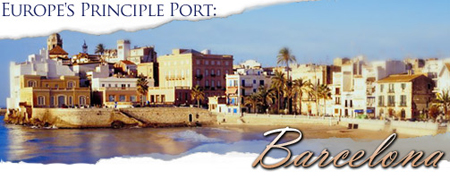|

Barcelona, Spain - A Holland America
Port
With
cultural roots dating back nearing 2,000
years, Barcelona is steeped in both
Spanish and Catalan traditions. The
bilingual city offers its visitors a
view of Spain's best entertainment,
nightlife, performing arts and cuisine.
As one of Spain's largest ports, Barcelona
is a principle port known throughout
Europe.
What
to See
A
tourist favorite, rising above the Barcelona
harbor is Hilltop Montjuic Park, which
was named for the Jewish community that
once lived on its slopes. It's popular
for the castle, amusement park, gardens
and cluster of museums that occupy the
land. If you are thinking of visiting,
a cable lift links the harbor to the
nearby park.
Barcelona's medieval Barri Grotic is
an open-air museum based in 12th- and
13th-Century architecture. When wandering
in the old quarters, stop in at a nearby
café to enjoy a quick bite. Many
of the nearby businesses make excellent
use of the area's old buildings.
The famous Picasso Museum is housed
in two of the district's striking 15th-Century
palaces. The museum's collection was
donated in both 1963 and 1970, first
by Picasso's personal secretary and
then by the artist himself. The exhibit
ranges from the master's childhood sketches,
to large posters made shortly before
he died. Of note are his unusual Blue
Period works and the variations on Velazquez's
" Las Meninas." Also in the
old quarter is Barcelona's Seu Cathedral,
which features beautifully carved choir
stalls. The cathedral's houses the saint's
tomb with the crucifix from Don Juan's
galley in the Lepanto Chapel.
The Las Ramblas is one of Europe's most
famous promenades, and a worthy visit
during Barcelona's summer months. Artisans
sell wares there from small booths along
the connected avenues. A tall column
at the foot of the promenade is dedicated
to Christopher Columbus. Along the route,
a fairly plain façade conceals
the Gran Teatre del Liceau's elegant
interior, covered with ornamental gilding
and plush red velvet fittings. Built
between 1845-47, the renovated theater
was recently re-opened in 1998.
Barcelona is a treasure chest of museums
and galleries. Though you will want
to start at the Picasso Museum, make
sure you don't miss out on the Catalan
Art National Museum - one of the world's
most expansive collections of Romanesque
paintings. The Montjuic's Joan Miro
Foundation contains an extensive collection
of Miro's colorful modernist work, while
the young at heart won't want to miss
the Tibidabo Mountain - the world's
only museum of automation. Also, don't
forget to take time and admire at least
a sample of Antoni Gaudi's architectural
wonders. The buildings aren't just housed
inside a museum, each one is its own
museum.
Barcelona is blessed with more avant
garde architecture than any other city
in the world. Though Gaudi lived decades
ago, the man was well ahead of his time
using recycled materials for many of
his creations. The United Nations World
Trust protects much of the artist's
work, the most visable of which is the
Landmark Catedral de la Sagrada Familia
(Holy Family Cathedral). The architect
didn't intend for the building to become
a church, though it did become his obsession.
He worked on it the last eight years
of his life, combining stone, iron and
ceramics in irreverent fashion. The
Josep Clara Museum of modern sculpture
is also a great point of interest for
travelers.
For a spectacular view of the city and
harbor, ride the funicular to Collserola
Tower on Vilana Hill. Designed by the
English architect Norman Foster for
the 1992 Olympic Games, the 1,000-foot
tower is the highest in Barcelona. In
clear weather, Pyrennees can even be
seen from the tower.
History
Barcelona's
whimsical, vibrant atmosphere makes
it an inviting place for visitors and
residents alike. City architecture is
unique, while friendly people seem to
almost dance along the wide boulevards.
If you're able to visit only one Spanish
city, Barcelona is an excellent choice.
The city's 3 million residents represent
the very soul of the Catalunyan region,
which dates back much farther than the
1978 Spanish establishment of the autonomous
communities. The Catalan people feel
a strong sense of cultural unity. Their
history, civilization, language and
character have been distinct for nearly
2,000 years. Further city treasures
include more than 70 museums, three
universities and 16 city parks.
Read more about the Holland
America 10-Day Mediterranean Cruise.
|